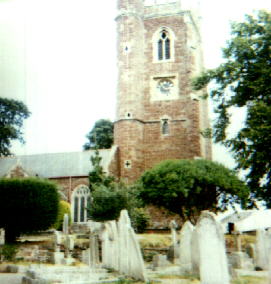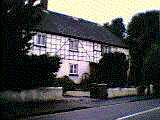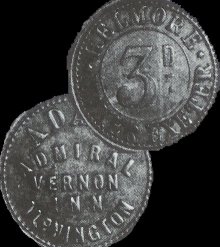
|

|
| Use the text links for more information! |
No sidebar menus?, Click Here and re-select |

|
ALPHINGTON
Alphington is one and a half miles from the centre of Exeter and
has a village atmosphere despite now being part of the City. The village
never got a mention in the Domesday Book (1086),
although the King had a manor called Alphintone, however a church existed here
after 1100. Alphington gets its name from an Anglo-Saxon farmer who owned
most of the land upon which the village is built. He was called Alfa. The 'ing'
bit means 'place of' and the 'ton' is referring to a settlement. Alphington
parish is in Wonford Hundred, and the Archdeaconry and Diocese of Exeter. The
early history of land ownership is somewhat confused, effectively though, the King
held the manor and let it to various families who sublet. JW Coles (1975), states that the
village passed into the Saxon King's hands in 658, and so remained until the Norman
Conquest.
Early lease holders were
Baldwin the Sheriff as part of the Barony of Okehampton (by 1100), and between 1142
and 1155, William Avenol. By 1284 (possibly as early as 1242), the Nevilles held it
'for homage and services of Hugh de Courteney'. In 1357, the manor was passed on to
John Burgeys (this bloke may well have been the MP for Barnstaple in 1360). It was
then purchased by Sir Hugh Seagrave who later exchanged it for Newham Courcy with
Sir Philip Courtney who already held Powderham.
From this time on (1382), the manor remained in the hands of the Courtneys.
The Church
The Church of St Michaels and All Angels is the centre-piece of Alphington
Village and as such has always figured highly in the history of the village.
The first mention of the dedication to St Michael can be traced back 1200 years.
The present building dates from around 1480. |
|
The west end of the church was probably built towards the end of the C14th, later
parisioners and the Earl of Devon paid £700.00 for the restoration of the church in
1477. The Courteneys (Earls of Devon)
had to get something out of their money. You just can't give it away! The porch is adorned
with the Courteney arms and has an upper storey with a Stoup (a basin for holding holy water).
An ancient piscina (stone basin for draining water) can also be found in the south
wall of the chancel.
Bells
In 1749, a peal of eight bells was hung having been cast by Bilbie of Cullumpton. At the time, it was the largest peal in the country. These eight bells were re-cast from the original five hung prior to 1550. Make sure your hangover has gone by ten thirty on a Sunday or you could be in for a shock. The tower was repaired in 1852, and the bells restored in 1939 at a cost of £525 4s. 11d. Unfortunately a load of dust got into the clock and this too had to be cleaned. |
The Font
A church inspection in 1887 caused the wardens and the
Rev Dr Dennet to ask an architect to take a look at the building. Their
report concluded that the church was in an extreme state of disrepair and
that burials ceased both within the internal vaults and outside. Excessive
use of the burial grounds had produced a bit of a stench inside the
church and had undermined much of the church's foundation. The report also
stated that the vaults inside the church should be cemented over. The furniture
also came under attack in the report. However the
Beer Stone
font was said to be one of the finest of its type in Devon. This
Saxon or early Norman font was kept when the church was restored and re-opened
on 25th July 1878. The Vestry is a more modern addition which came with the re-opening
of 1878.
The Lady Chapel was restored in 1930 using panelling found stored in the rectory. Six
carved oak pews were placed there in 1936 by the Bonus's. The church registers date from
1603 and have been placed with Exeter City Library.
|
Arson
Severe damage was caused to the church in October
1986 by an arsonist, £60,000 was raised on top of the £365,000
insurance settlement to restore the vestry, loft, roof and ceremonial items. A
new organ was also required and this alone cost £80,000. Following this restoration,
the first service was held on the eve of the feast of St Michael on 28th September 1987.
Civil War
Parliamentary troops used the church as a stable
in 1644 during the Civil War and in 1645, sensing the strategic importance
of Alphington, after defeating the Royalists at Powderham, General
Fairfax made his headquarters here whilst he put the final touches to his
plans for the Parliamentary victory in 1646.
I have also read that Parliamentary troops occupied the Admiral Vernon Inn.
However the Inn was then possibly known as the Church House (Inn) and stood on the corner of Ide Lane where the Old
School now stands.
The Exeter Housing Society building in Chudleigh Road was formerley The Admiral (Vernon) Inn before closure in 2006, but this was
not the building occupied by the troops. This building was then a private residence known as
Burgoynes after the owner, William Burgoyne (first registered in 1704). Many of the buildings and houses you'll see
on this tour of Alphington are named after their original owners. The Church House will have been built just prior
to the church in the late C15th (some say 1480) to house the builders and craftsmen working on
the Church, and later to house visiting preachers. |
| The Village grew on the flood plain of the Exe, with the marshes of Marsh Barton stretching away eastwards. Alphington has in the past avoided floods from the river but not from Alphin Brook. Flooding however is now a distant memory, the brook having been canalized in the 1960's. Despite Marsh Barton having been heavily developed as a trading and industrial site, there was no flooding during October and November 2000 unlike several other areas of the country. The development of low-lying areas which are natural soak-aways for flood water is always folly, however in this case, the council appear to have got away with it by building relief channels and canalising the streams. |  |
 |
Cartwheels
To your left is Cartwheels which was built at around the same time at the current church
(aprox 1480).
It was built into the wall surrounding the old rectory to stop prying eyes from the
residents of Alphington. The building is of cob
and timber and that seen today has had the outer layers of cob removed to expose the wooden
joists and beams. These have been treated and the cob re-sealed with whitewash. It has been
related to me that this cottage was once called Flint Cottage. I wouldn't mind betting that it
was flint chips that were removed to expose the joists and beams.
|
| The Admiral Inn
The Exeter Housing Society now own the building that was formerley the Admiral Inn.
The Admiral Inn (formerly the Admiral Vernon Inn and Bell Inn) was a busy pub that incorporated a restaurant.
There were bottled beers and a real ale available. The food was very good especially if you liked steaks.
Thursday nights featured a Steak Stampede where you could eat for very reasonable prices. Before 1999, it was a Thai
restaurant (from the mid 1990's) and prior to that a pub with a lounge and public bar.
Unfortunately the pub closed in May 2006 after a buyer for the business failed to materialise.
Admiral Vernon
died in 1757, the pub will no doubt have been named in his memory or his exploits. There were once
many pubs bearing his name but these were later altered to Frederick the Great
or Wellington.
The 'pop up' gives details of the major Spanish conflicts he was in involved in. He was
also the man responsible for Grog.
|
| Horse Fairs
From 1682 to the latter part of the C19th,
Alphington was famous for its Cattle and Horse Fairs and as a rendezvous
to get transport to Haldon Races. The Horse Fair was the biggest in Devon
and drew people from miles around. A great number of gypsies attended,
most of them equine experts so while they practised horsey stuff, their
wives told people of their fortune. The fair lasted two days and because
of this 23 public or 'bush' houses were set up to cater for the crowds of people.
The fairs took place on the first Wednedsay after 20th June and also on the Wednesday
after Michaelmasday. The 'bush' houses were so called, because when the beer and or cider
was ready, a bush was hung outside the establishment. This practice it seems was not limited
to Alphington, blackthorn bushes were hung outside many of the ale houses in Exeter in the early
C14th and very possibly before. |
The King William, Double Locks,
The Bell and the Admiral Vernon all did good trade.
Sadly only the Bell Inn is left in the village from this age (now bearing the name Admiral Vernon Inn) with the Double Locks
a short walk (20 minutes) away.
For the priveledge of holding the fair, rent was paid to the Lord of the Manor. The fair was originally held in the road leading to Shillingford near Clapperbrook Lane, but was later moved to a site now occupied by the Fairfield Estate built in the early 1960's. The Michaelmass Fair was the biggest fair and was known as Goose Fair, frequented by geese eaters. Up to sixty Geese were cooked at the old Admiral Vernon to provide a feast for the visitors. The geese were first boiled and then browned on a spit. Perhaps it was apt therefore that the Admiral Vernon (then the Bell Inn) had a restaurant in its later years. Goose was not on the menu however but they did a mean spicy chicken baguette. The last Cattle & Horse fair was in 1870. |
|
Version 1 of The Admiral Vernon used to stand by the corner of Ide
lane on the site of the old school but this was destroyed by fire on 15th September 1871, after this in
1883, the Bell Inn became the Admiral Vernon Inn (J.W. Coles).
The tennant at the time was Joseph Richards who had leased the Bell Inn from a William Loram. William Loram sold the pub to St Anne's Well Brewery in 1895 (deeds) and moved to Brooklands (J.W. Coles). William Loram is listed in White's Devon Directory as a Butcher. The Bell Inn or Olde Bell Inn was originally a private residence known as Burgoynes after it's owner William Burgoyne listed there in 1704. Click here for a floor plan of the Bell Inn. The 'pop up' is mapped. By moving your cursor over the image, text boxes will describe the original building in more detail and how this relates to the present day building. |
Briefly though, Lamp Cottage, the Bell Inn and the cottage next door were at some stage interconnected buildings,
possibly that of a poor house. This poor house may possibly have been built on a second strip of land given to the St Michaels and
All Angels in 1512.
A more likely scenario though was the Bell Inn's expansion into neighbouring properties during the height
of the coaching days in the C18th followed by regression to a single building with the demise of the coaching
trade. Lamp cottage (now demolished) also at one-time had a turret which was used
by the Bell Inn to look-out for coaches in order that fresh horses were ready upon the arrival of the coach
before the ascent over Haldon. Next stop would have been Chudliegh.
Original beams can be seen in the roof and in the former restaurant on the wall used to hang a framed piece of original wood
panelling.
|
The building seen today underwent a fairly major structural change in 1964, with the
reconstruction of a new lounge and bar, a flat roofed extension was added out back, now housing the WC.
In the lounge, light oak panelling was used with driftwood doors. The lounge kept the original oak
ceiling beam with a tile floor installed in the public bar. This has since been covered with parquet flooring. The
fireplace is of Stoneycombe stone and incorporates a granite gatepost as a horizontal support.
The original lay out was somewhat different than today. The front entrance as seen today led directly onto a long corridor than led straight to the back door. On each side of this corridor were the drinking areas, the bar was along the back-wall of the bar seen today. Presently the bar inhabits what would have been this long corridor. This design was very typical of houses built in the C16th and is replicated in The Double Locks Hotel which was built in 1701. Of course further renovation has taken place during 2008 after the building was sold to the Exeter Housing Society. |
|
Husseys hold sparse details of an auction at Langford's Bell Inn in 1857. The tennant at the time
was Thomas Langford.
The occupier of the original Admiral Vernon Inn on the corner of Ide Lane, escaped the fire with his wife and four children. Their surname was Foefees. However, they sub-let from William Gover. JW Coles, 'Echoes of Alphington' states that the Church House was occupied by the Admiral's Head until 1814 and then The Admiral Vernon Inn. White's Devon directory (1850) lists two further pub owners / tennants in Alphington, Thomas Carpenter, who ran the King William and a Thomas Pennyman who ran the Double Locks. There are three pictures in the Church 'glory hole' showing the original Admiral Vernon opposite the war memorial triangle. Two water colours (1833 and 1850) and an oil painting which is older. At that time, several cottages occupied the triangle, one of these became the Eight Bells Inn. |
|
Both versions of the Admiral Vernon issued checks which were used like money. They were tokens and may have
been given as change or as a prize for possibly winning a skittles match. Either way they were redeemable for beer.
Three sets of coins are known to have existed. The original pub issued a very crude token between 1866 and 1870
when H. Mitchel was resident. John Routley issued more between 1883 and 1890, this was after he had taken over at
the Bell Inn. The tokens shown were issued between 1875 and 1905 when a man named Adams was resident.
Husseys advertised a timber sale at the Admiral Vernon on 17th January 1837 and a Livestock Auction in 1892. There is also a poster in the pub advertising an auction at Lamp Cottage (which used to stand at the entrance to Lucerne House) in 1889. Perhaps though of more significance is an advertisement in the Western Times (19th September 1846). This was before the pub re-located to the Bell Inn. The pub was descibed as the Admiral Vernon Inn and not the Vernon's Head. The full text of the advert is shown below. Mike, formerly the pub's landlord also showed me an old picture of the pub taken on 23rd July 1932 just prior to the pub regulars' annual outing to Bigbury Bay. Until 6th September 2002 this was the last pub outing. However, on this date, pub regulars visited O'Hanlon's Brewery near Whimple for a drunken night out. The Express and Echo recorded the event. |

|
| WESTERN TIMES, EXETER 19th September 1846.
ADMIRAL VERNON INN. To let, with immediate possesion that old established and well accustomed public house The Admiral Vernon Inn. Situated at Alphington in a populous and thriving neighbourhood with good stabling, covered skittle alley, brewhouse and every requisite accomodation. The above affords an elegible opportunity to persons of small capital as the stock is much reduced. Rent moderate. For particulars apply on the premises. |
|
This Admiral Vernon (version 2) was still thatched during WW2. A story in the parish magazine during the
war tells of the Home Guard drinking there. One of their guns went off, the bullet going through the ceiling,
through a bed and chamber pot and lodging in the thatched roof.
During the late C19th, the place was also a coaching house. In a letter to William Loram in 1889, John Routley (the tennant) mentioned that the Ostlers's room was in a bad state of repair. An Ostler was man responsible for changing and looking after horses for the coaches. Ostlers also often had problems with their toes because the horses kept stamping on their feet. Ostler's Toe is now known as Onychogryphosis (say that when you're pissed). It is a thickening and curling of the nail due to damage at the root. The Donkey and the Shilling
Early in the C19th, in early August, Haldon Races were held on a Wednesday and Thursday. The main route from Exeter to Haldon was via Alphington and so the village became a wagon, cart and donkey station to serve the race track. Wagons and carts cost a shilling and donkeys were sixpence. The journey was five miles during which many accidents occurred especially during the descent on Haldon Hill without brakes. If you descend Haldon Hill nowadays on the A38, you'll notice escape roads. Imagine what this was like in a cart. Bungee jumping was for pussys in those days. The route was via the Shillingford Road which led on to Clapham, and then over Haldon emerging at the fork at Chudleigh. In 1822 however, a new road was built from the bottom of Telegraph Hill to Chudleigh. This was the new road to Plymouth. |